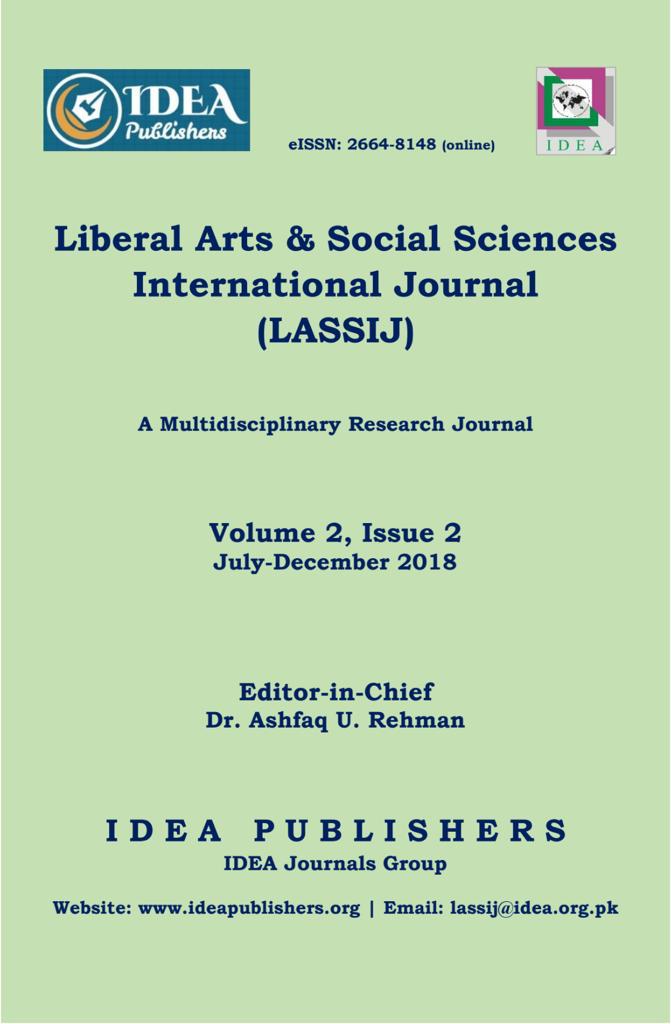Gender Inequality in Education: An Analysis of Socio-Cultural Factors and Impacts on the Economic Development of Malakand, Pakistan
DOI:
https://doi.org/10.47264/idea.lassij/2.2.6Keywords:
Gender, Inequality, Education, Socio-Cultural Impediments, Human Capital, Economic StabilityAbstract
Women’s education is the most effective channel for reducing the inequalities between men and women and ensuring the maximum participation of women in the developmental process. This study is conducted in Malakand Division of Khyber Pakhtunkhwa Pakistan. Further this Paper explains the socio-cultural reasons of gender inequality in education, and to investigate that how this inequality affects the economic stability. The data is collected through questionnaire from 165 household using cluster random sampling technique. Chi-square test and correlation technique are utilized for the verification of hypotheses which proves that the gender inequality in education is as an endogenous variable and show that it can be explained to a considerable extent by cultural-religious preference, and regional factors. It is concluded from the study that, gender disparity in education reduces human per capita income. The study suggests that to improve human development in the context of per capita production, women’s education must be improved through the elimination of disparity in the text and by relaxing the socio-cultural factors.
References
Behrman, J. R., & Deolalikar, A. (1988). Health and nutrition. In Handbook of Development Economic. Eds., Hollis Chenery and T. N. Srinivasan, Vol. 1, Amsterdam: North Holland Publishing Company.
Behrman, J. R., & Wolfe, B. L. (1984). More evidence on nutrition demand: Income seems overrated and women's schooling underemphasized. Journal of Development Economics, 14(1), 105-128.
Behrman, J. (1997). Mother's schooling and child education: A survey. Unpublished manuscript. Philadelphia, PA: University of Pennsylvania.
Chaudhry, I. S., & Rahman, S. (2009). Impact of gender inequality in education on economic growth: An empirical evidence from Pakistan. European Journal of Economic, Finance and Administrative Sciences, 15(1), 174-188.
Chaudhry, I. S. (2010). Poverty alleviation in Southern Punjab (Pakistan): An empirical evidence from the project area of Asian Development Bank. International Research Journal of Finance and Economics, 23. Retrieved from https://waseb.wordpress.com/2010/04/20/poverty-alleviation-in-southern-punjab-pakistan-an-empirical-evidence-from-the-project-area-of-asian-development-bank-by-imran-sharif-chaudhry/
Cohen, D., & Soto, M. (2001). Growth and human capital: Good data, good result. Journal of Economic Growth, 12(1), 51-76.
Hannan, C. (2004). Director United Nations division for the advancement of women: Gender equality and women’s empowerment in the new millennium. In Interfaith Institute-Women: Her Spiritual Journey. Litchfield, CT: Wisdom House.
Jejeebhoy, S. (1995). Women’s education autonomy and reproductive behaviour: Experience from developing countries. Oxford University Press.
King E. L., & Hill, M.A. (1993). Women’s education in development countries: Barriers, benefits, and policies. The World Bank.
King, E. L., & Hill, M. A. (2001). Engendering development: Through gender equality in rights, resources, and voice. The World Bank
Klasen, S. (2002), Low schooling for girls, slower growth for all? Cross-country evidence on the effect of gender inequality in education on economic development. The World Bank Economic Review, 16(3), 345-373.
Knowles, S., Lorgelly, P. K., & Owen, P. D. (2002). Are educational gender gaps a brake on economic development? Some cross-country empirical evidence. Oxford Economic Papers, 54(1), 118-149.
Krueger, A. B., & Lindahl, M. (2000). Education for growth: Why and for whom? National Bureau of Economic Research, Working Paper No. 7591. Retrieved from, https://www.nber.org/papers/w7591.pdf
Lagerlof, N. P. (2003). Gender equality and long-run growth. Journal of Economic Growth, 8(4), 403-426.
Mensch, B., Lentzner, H., & Preston, S. (1985). Socio Economic Differentials in Child Mortality in Developing Countries. New York: United Nations.
Mishra, R. C. (2005). Women Education. New Delhi: A. P. H Publishing.
Montgomery, M. R., Arends-Kuenning, M., & Mete, C. (2000). The Quantity-Quality Transition in Asia. In Population Change in Asia: Transition, Development, and Aging, edited by Cyrus Chu and Ronald Lee; a supplement to Population and Development Review, Vol. 26. Nussbaum, Martha.
Raynor, J., Wesson, K., & Kyenes, M. (2006). The girl’s stipend programs in Bangladesh. Journal of Education for international Development, 2(2), 1-12.
Sen, A. (1990). Gender and cooperative conflicts. In Persistent Inequalities, (ed.) by Irene Tinker. New York: Oxford University Press.
Schultz, T. P. (1993). Returns to women's education. In Women's education in developing countries: Barriers, benefits, and policies, by Elizabeth King and M. Anne Hill (Eds.). Baltimore, MD: The World Bank.
Schultz, T. P. (2002). Why governments should invest more educating. World Development 30(2), 207-225.
Schultz, T. P. (1997). Demand for children in low-income countries. In M. Rosenzweig and O. Stark (eds.). Handbook of Population and Family Economics. Amsterdam: North Holland Publishing Co.
Strauss, J., & Thomas, D. (1995). Human resources: Empirical modelling of household and family decisions. In Handbook in Development Economics (Eds.) by Jere Behrman and T. N. Srinivasan, Vol. 3A, 1883-2023, Amsterdam: Elsevier.
Todaro, M. (1997). Economic Development (6th Ed.). Reading, Mass Addison-Wesley Publishing.
Ullah, K., Mustafa, J., & Badshah, S. (2017). Gender-wise perception of graduate and undergraduate students about the quality of teaching. Liberal Arts & Social Sciences International Journal (LASSIJ), 1(1), 10-19.
Yamarik, S., & Ghosh, S. (2003). Is female education productive? A reassessment. Medford, MA: Tufts University.
Downloads
Published
How to Cite
Issue
Section
License
Copyright (c) 2018 Umer Daraz, Akhlaq Ahmad, Muhammad Bilal

This work is licensed under a Creative Commons Attribution-NonCommercial 4.0 International License.
Please click here for details about the LASSIJ's Licensing and Copyright policies.















